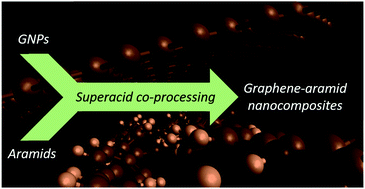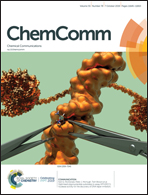Graphene–aramid nanocomposite fibres via superacid co-processing†
Abstract
The development of graphene–polymer nanocomposite materials has been hindered by issues such as poor colloidal stability of graphene in liquid media, weak interactions between graphene and the host polymers as well as the lack of scalable and economical graphene synthesis routes. Chlorosulfonic acid (CSA) can spontaneously disperse graphene without the need for mechanical agitation, chemical functionalisation or surfactant stabilisation,1 however is incompatible with most polymers and organic materials. Here, we demonstrate how poly(p-phenylene terephthalamide) (PPTA) – the polymer which constitutes Kevlar – can be co-processed with graphene in CSA and wet-spun into nanocomposite fibres with minimal aggregation of graphene.



 Please wait while we load your content...
Please wait while we load your content...